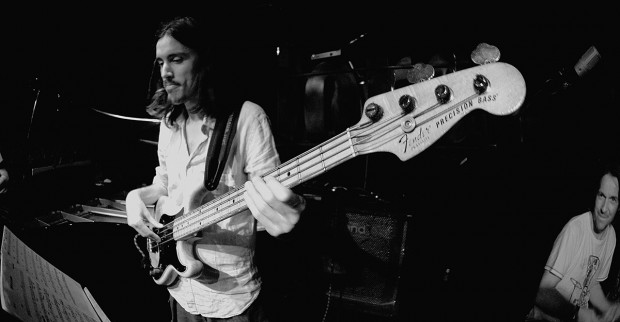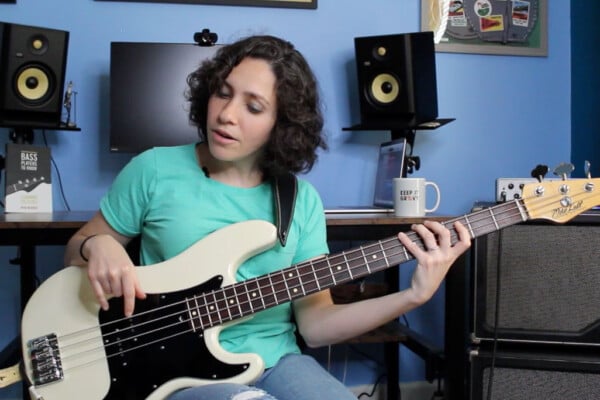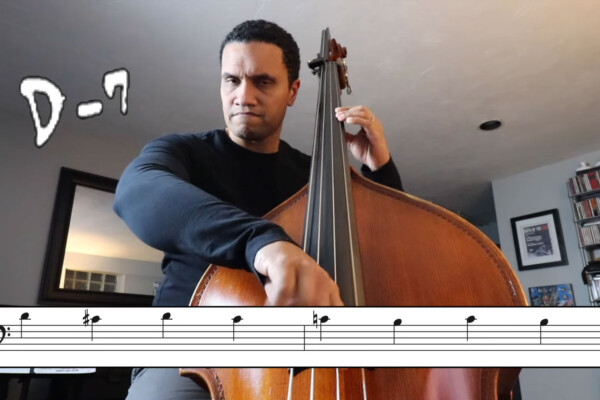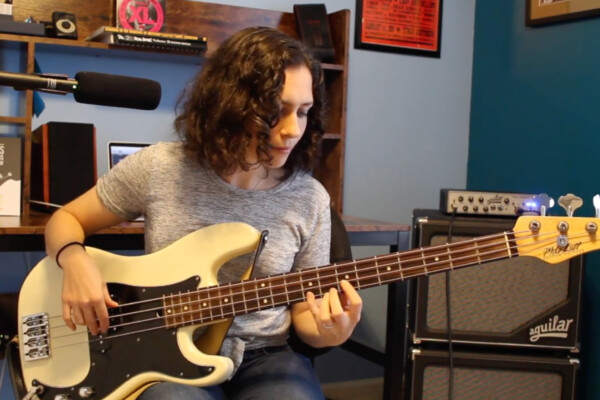Freeing Up Your Walking Bass Lines

Q: I’ve been getting my walking together and have started to become comfortable and natural sounding playing perfectly functional harmonic lines through changes that highlight the harmony well. It’s all just basically chord tones and scalar patterns with occasional chromatic approaches. In sum, I think I’ve passed walking 101 and am ready to move on.
When I listen to and try to emulate some of the great players, I notice they are much more free in their walking. Their walking lines sound more adventurous and less strictly confined to what the harmony is, yet they somehow still support the band just fine. This often surprises me because I’ll transcribe something and wonder how in the world the player’s line sounds so good with some of the notes they are playing against the harmony.
I also notice the great walking players have lines that almost sound like counter melodies in their own right despite being mostly all quarter notes. My lines, in comparison, sound rather rigid despite being perfectly functional harmonically.
So I was hoping for some ideas in regard to getting my walking to sound less stiff and more free and melodic while still maintaining the basic function of supporting the harmony.
As a second brief point, if you don’t mind, I’d love to hear your thoughts on approaching walking on the electric bass as that is all I play. Do you take any different approaches than what an upright player might take?
A: I love this question!
I am going to address the second part of your question first because it will likely provide some perspective and foundation for the rest of my answer (“answer” seems the wrong word. “Thoughts” is more accurate).
Electric bass is definitely a different animal when it comes to walking bass lines. It is a different instrument! Granted, it is providing the same function, but it will be different because it is different. The differences are numerous but, primarily, these are things I struggle(d) with playing electric bass while walking:
- You can hear absolutely every note. Even if you are comparing an electric to a well amplified upright with a great microphone, you just can’t hear every little thing that comes out of the bass like you can with an electric bass. Even EUB (electric upright basses) still have a thicker and rounder sound than most electric basses (unless you go to extremes with on-board EQ on either instrument).
- The sound of an electric bass cuts through the mix more efficiently. Very much related to my first item but slightly different and worthy of it’s own acknowledgment.
- We are very accustomed to hearing an upright in certain musical situations and therefore may have a bit of semi-conscious resistance to the sound of an electric.
With these three simple points in mind, I believed that you just couldn’t get away with certain things on an electric for quite a while. I’ve begun to swing back the other way but I think the truth is right there in the middle and I’ll explain why.
It is true that certain notes may seemingly rub quite a bit more on an electric than an upright bass, and that makes it safer to stick to solid chord tones and well considered approach notes. But there is more to the story than scale degree. When I’ve had those kind of “how does that note sound so good when it is so seemingly unrelated to the harmony” moments while transcribing, my answer often led in the direction of context and resolution than something like “it’s an upright thing”.
I find that:
a) When the line completely deviates from the harmony: the line is usually a strong melodic statement which both stands up on it’s own and resolves back to the actual harmony.
or
b) When the line line completely deviates from the harmony: the bassist is outlining his own changes or a variation or possibly even another chord change that somebody else alluded to somewhere.
In either of these cases, the result is the same and is often actually both. An interesting walking line is really all about melodic relevance, tension and release (in addition, of course, to it’s actual function of outlining harmony and providing a string pulse). If I play a line that starts out with a strong melodic statement that makes it’s own kind of sense, and then resolve it strongly; it will work.
That said, I think that it is much easier to pull this kind of thing off on an upright than it is a modern electric bass. There are some electric basses that can pull of a respectable EUB type sound and the reality is that, the more like an upright it sounds, the easier it is to make that “outside” stuff work for you.
Tempo can also play a factor. The faster it blows by, the less time it has to offend. Uptempo swing is ripe for made up changes, extended chromatic passages, etc…
As a rule, I tend to keep my walking lines pretty inside and instead focus on feel. I’m more worried about providing support than standing out. However, when I do really start to stretch, it is often because the band is just totally cooking and and I am inherently more “in the zone” in these moments. I have a keener sense of how to makes things work in addition to being more tapped into the real movement of the musicians around me. In those moments, notes don’t matter quite as much as energy, passion, interaction and flow. Instinct takes over in those moments and it’s hard to quantify why something worked or didn’t beyond energy and oneness with the situation and musicians around you. The metaphysical side of music can’t be practiced, unfortunately.
I also believe that it’s important to record and re-evaluate things again later. Many times, I can be completely dissatisfied with something I played in the moment only to realize that it’s kind of cool later on. Sometimes we have expectations or pre-conceived sounds in our minds ear and grimace when we stray from that only to realize that we just weren’t being open to the music as a whole.
The music being made is much larger than the sum of it’s parts.
As a more tangible example of what I’m talking about:
I may be hearing a ?6 in my minds ear (over a minor chord) as I reach for it. The pianist may play a natural 6 (Dorian). I’ll likely wonder why my b6 sounds so bad.
Or…
I may hit a natural 6 but have the sound of a b6 in my minds ear so it’ll sound wrong to me when, in actuality, it sounded right in the context of the band as a whole.
If I’m not in tune with the sound of the band as it’s own entity but, am over concerned with my bass, I am more likely to dislike what I played and I am simultaneously less likely to really get ‘in the zone’.
Not much comes to mind with specific things to work on beyond what you mentioned already (chromatic approaches, etc.). What I sometimes do as an experiment, at home, is to:
- Walk 4 choruses of a tune.
- Scanning ahead as I go, pick strong places in the phrase to lock in and be intentional with how I resolve a line and start up again.
- In between those points of intentionality, I simply use my ears and intuition and try and ‘hear’ my way through the changes.
- Playing half-steps, whole-steps and intervallic leaps where I hear them and make educated guesses.
I try and play the sound more and worry about changes less. It is important (for me anyway) to force myself to come back to the actual changes in key spots to re-anchor myself to the music but this might not be necessary for everybody.
Often times, it is our perception that ruins a note. Every “wrong” note is an opportunity for a motiff, in a way. There is no such thing as a wrong note, just a bad resolution. If we can learn not to fear wrong notes, we will be more likely to use them in interesting ways. Every note outside the harmony wants to get back in. It’s up to you to figure out how to do that and break the habit of cursing yourself and pretending you didn’t play that G? when you meant to play a G natural. Use that G? as an interesting way to get back to wherever it wants to go!
As a final thought, I’ve begun to think of the changes in straight ahead jazz or bop as guidelines and not gospel. Many chordal instrumentalists have their own favorite changes to many of these tunes anyway, so it is important for you to be able to hear what might work equally as well as you could play it off of a page.
Have a question for Damian Erskine? Send it to [email protected]. Check out Damian’s instructional books, Right Hand Drive and The Improviser’s Path.




I loved this question as well Damian. Your points as always were on point and give me something to work on. I’m an electric bass player who has a deep love for jazz. I live in Washington DC and there is not a tremendous amount of love for it in straight ahead jazz. It’s a tough nut to crack and I’m hoping I don’t have to dive into upright in order to pull it off.
“The metaphysical side of music can’t be practiced, unfortunately.”
I’m appalled by this statement: Practiced should be spelt with an ‘s’!
It’s actually a good article, thanks.
I’m gonna throw my own positive spin and say, to the guy who asked question, that you’ve noticed that your playing is more static than it could be and that’s half the battle. You can’t fix something if you don’t know what you’re doing wrong.